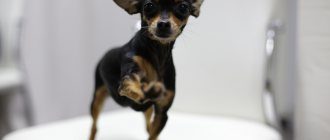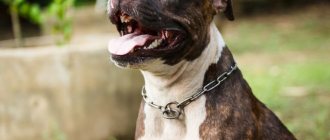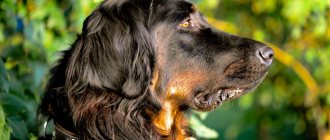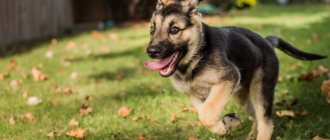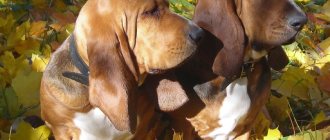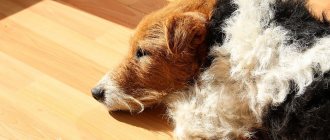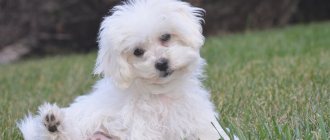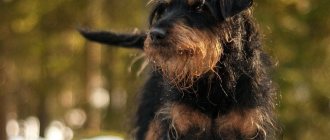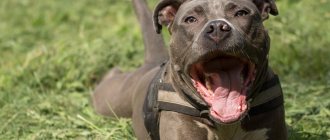06/30/2019 Irina Malinina 0 comments
The Staffordshire Terrier is a fighting dog, the sight of which makes many people panic. Most people consider representatives of the breed to be killer dogs, and only a few understand that improper upbringing or lack thereof makes animals angry and uncontrollable. At the same time, competent upbringing works wonders: the staff terrier will become an excellent companion and loyal friend.
The American Staff Terrier is considered a potentially dangerous dog in Germany, but at the same time in America, Staff Terriers are very popular among family people.
Staffordshire Terrier - a brief description of the breed
Representatives of the breed are brave and courageous dogs. They are energetic and loyal, caring, sociable and inquisitive. They easily get along in almost any family, finding an approach to people of all ages.
All the best qualities of a dog will appear only if it has good heredity, and a responsible owner has devoted sufficient time to its upbringing and training.
The Staffy can be an excellent watchdog or bodyguard, he performs well as a service dog and even works in hospitals and nursing homes as a therapy dog.
A staff dog needs an experienced owner who can take a leadership position.
For this reason, it is better for an inexperienced person not to own this breed. Also, very busy, sedentary or lazy people should refrain from purchasing staff.
Learning ability
It is better to start training your staff as early as possible. These dogs are extremely smart and, with the right approach, are perfectly trainable in any type of canine sport - from agility to complex types of training. However, they can be stubborn - then the owner will need a fair amount of patience, consistency in behavior, as well as constant praise and proper reinforcement of the pet
Despite their brutal appearance, they are vulnerable creatures, so their training is much more successful if you work with them, avoiding rudeness and overly harsh influences. It is very important to socialize your puppy as early as possible. The Amstaff is very dependent on the mood and character of the owner, the dog adapts to him even in small things, so these dogs are not suitable for an unbalanced person.
This breed requires frequent physical activity, as well as constant mental work. They need to exhaust their energy by doing different interesting tasks. Otherwise, a bored staff member will chew the walls, gut the sofas and turn the yard into a lunar landscape with craters. Various fables about this breed are being circulated in the press, which have nothing in common with reality, and every well-trained staff can put an end to the absurd fictions and rehabilitate their breed.
History of appearance
For the first time, history presents us with the Staffordshire Terrier as a fighter, bred specifically for the terrible and bloody spectacles of dog fighting, which were very popular in the 19th century.
The new breed appeared thanks to the union of a bulldog and a terrier.
The result is an excellent killing machine, combining the aggression of a bulldog and the mobility of a terrier. The dog fought to the last, despite his wounds and without feeling pain, which caused constant delight among the audience.
Over time, the names of the dogs changed: the animal was both a bull terrier and a pit bull terrier. Only towards the end of the 20th century was a permanent name assigned to the breed and its standard approved.
Today the Staffordshire Terrier is simply called the Staff or Amstaff. These names are shorter and more convenient.
After dog fighting lost its relevance, the dog began to be used as an impartial guard and a good hunter. The animal was given the status of a farm dog.
Today, many families prefer the Amstaff, keeping him as a pet. Responsible people who treat their four-legged friend with love have proven that a bruiser with a stern appearance can be turned into an affectionate and devoted pet.
Origin
There are perhaps few dog breeds that have had to go through as many facets of human cruelty as the Staffordshire Terrier. Legends say that these animals were bred for only one purpose - to participate in battles and kill their own kind. It has been proven that their ancestors were small baiting dogs from Spain, Italy, and England. For centuries, they were participants and silent witnesses to the most cruel games of their eminent owners. The 18th century is considered a turning point in their history.
It was at this time that a radical change occurred in their positioning. Staffordshires began to be considered as loyal and very intelligent companions of man, distinguished by incomparable security characteristics. It’s not surprising, because they harmoniously combine everything: intelligence, size and a brave, loyal heart. Already in the 20th century, these dogs began to actively populate the farmlands of capitalist America. From that moment on, they became part of the family and participants in a huge number of exhibitions.
The official beginning of the formation of the breed was laid in 1898, when this dog first appeared under another, no less famous name - the pit bull terrier. Over the long history of their formation, Stafford dogs have changed many names, and received final recognition only in 1972.
Dog appearance (standards)
Dimensions
Adult dogs range from 43 to 48 cm in height, with females only slightly smaller than males. Weight usually ranges from 25-30 kg.
Wool
The dog's coat is short, rather thick, and straight. It fits tightly to the body, shiny in appearance and hard to the touch.
Colors
The standard allows any solid color except white, as well as two-color, spotted, brindle.
Head
The Stafford dog has a wide, massive head with a pronounced transition from the forehead to the muzzle.
Teeth and jaws
The animal's jaws are wide and strong, have a scissor bite, and white teeth.
Eyes
The wide-set eyes are round in shape and dark in color.
Body and limbs
The Staff breed is characterized by a muscular build.
Dogs have a short back, a tucked belly, and a wide, powerful chest. The limbs have prominent muscles and are distinguished by strong bones. Arranged in parallel.
Tail
The short straight tail tapers towards the end.
Photo: https://pixabay.com/photos/staffordshire-bull-terrier-2379364/
Rock defects
The disadvantages of the breed include the following:
- light eyes;
- a long tail;
- barrel chest;
- caries;
- undershot;
- obesity;
- underdeveloped muscles;
- rough or light boned;
- cowardice;
- aggressiveness;
- mental instability.
Differences from pit bull (American pit bull terrier)
Amstaff and pit bull are two types of the same breed. They are sturdy, medium-sized dogs that are the epitome of strength. To see the external differences, just look at a photo of a Staffordshire Terrier and a photo of a Pit Bull Terrier. The Amstaff has a more proportional physique, while there is some disharmony in the appearance of pit bulls.
The American Pit Bull Terrier can last in a fight for up to three hours and, accordingly, is tougher than the Staffordshire Terrier.
Pit bulls are smaller in height and weight. But their heads are larger and their jaws are more powerful.
As for character, there are also differences. The Staff breed is more docile and less aggressive than pit bulls. Staffertiers remember commands better and are considered more diligent; their behavior shows a desire to please their beloved owner. At the same time, both breeds have high mental indicators.
We study Stafford in detail
The Stafford dog looks great in appearance. Thanks to his fighting qualities he has:
long strong legs;
short hair;
strong, strong muscles that stand out when running or other physical activities.
Many people are interested in: “What does a Stafford dog look like?” The answer is obvious: powerful, smart, beautiful. The height of the dog is on average 45 cm, while the weight is quite large - up to 30 kg. The color is either solid or spotted.
The dog has enormous physical capabilities and sporting potential. It needs to be actively developed. For these breeds there is a special set of exercises in the gym.
Staff character
The Staffordshire Terrier is an animal with a contradictory character. An intelligent dog, calm and able to hold himself in his “paws,” deep down in his soul he still remained a fighting dog with a rather complex disposition.
The owner, and the whole family, must demonstrate their importance to the dog and become a real authority in its eyes. If this cannot be achieved, the Stafford dog can at any time take out aggression on each family member.
Staff is a sensitive and sensitive nature.
It is not recommended to raise your voice at your pet, much less hit it. Aggression will only generate aggression in response. The dog is able to sense the tense atmosphere in the family. She will understand that the owner has problems and will silently support him. Or he won’t bother you with his presence and will quietly step aside.
The Staff Terrier is suitable for calm people who do not tolerate fuss and excessive activity around them.
If a dog burns out its energy on a walk, it will be quiet at home.
Photo: https://pixabay.com/photos/dogs-american-stafford-2412313/
The fights in which dogs took part developed their intelligence and taught the animals to make independent decisions. At the same time, the staff is able to distinguish a real threat from a fictitious one. If you raise your pet correctly, it will make an excellent companion.
The Staffordshire Terrier is very calm towards its own kind and is quite difficult to anger. But if the enemy succeeds, the staff will become a very dangerous participant in the fight.
Dogs of this breed are completely fearless.
American Staff Terriers very quickly adapt to new conditions and even become attached to the new owner. These dogs are not monogamous. In the distant past, they were often sold, which forced the animals to become more flexible.
Is Amstaff a killer dog or not?
According to popular belief, the Staffordshire Terrier poses a danger to the people around it. Is it so? This question can be answered in the affirmative only if the dog is adopted by an aggressive person, dissatisfied with life, who asserts himself by instilling aggression in the pet.
The aggressiveness of a dog directly depends on the aggressiveness of the person raising it. Or from irresponsibility and unwillingness to take care of a pet. Lack of free time will also play a bad joke; a dog left to its own devices can grow up to be anything it wants.
In defense of the staff, it must be said that it is not their fault that people brought them out for bloodshed and raised them to be cruel and merciless. Love and respect for a person, proper upbringing and responsible training will help turn a potential villain into an irreplaceable friend, ready to do anything for the sake of his loved ones.
The family where the dog is loved, socialized in a timely manner and raised correctly receives an affectionate pet, good-natured and peaceful, who poses absolutely no threat to others.
It is not the dog that is dangerous, but the stupid, evil owner who decided to purchase the staff.
Attitude towards the owner
The Staffordshire Terrier is a family dog. She loves her owner and everyone else very much and tries to spend as much time as possible with her loved ones.
Photo: https://pixabay.com/photos/staffie-bull-terrier-staffordshire-2159307/
The breed is inherently lazy. But despite this, dogs always strive to please their owner. They are able to support or console, or simply keep company at a time when a loved one is feeling bad.
Attitude towards children
Staff dog owners claim that a well-mannered dog is a child’s best friend. She will tolerate any pranks and will never harm a little person. Despite this, it is still not recommended to completely trust the animal and leave it alone with small children.
In parallel with raising the dog, raise your children, teaching them the correct attitude towards their four-legged friend.
Attitude towards strangers
The Stafford dog is wary of strangers and is a good guard. She may become aggressive towards strangers if she decides that strangers pose a real threat. Moreover, the dog will protect not only loved ones, but also their property.
The animal that enters the fight will fight until the enemy submits.
In situations where there is misunderstanding, this feature of a strong dog is very dangerous.
How did the breed appear?
The Stafford dog breed has been known since ancient times. So, in 1209 there were the first mentions of it. It is a mistake to believe that these dogs originated in America; in fact, their homeland is England. Dog breeders claim that the Stafford has many other names, such as American Terrier, Pit Bull and many others. The thing is that at certain time periods the animal was assigned different roles. They were used for fighting. Gladiator games faded into the background; instead, animal slaughter appeared: monkeys and others.
Initially, mastiffs were used for fighting. But often the dogs lost due to their large build and clumsiness. It was an ideal target for big rivals. Dog breeders decided to reduce the size of the dog by crossing a terrier and a bulldog. As a result, the new animal became more flexible, cunning, and nimble.
When you first look at a Stafford, it seems like a predatory animal is looking at you. But in fact, this dog is quite kind and friendly. She is very attached to her owner, ready to give her life for him. It is she who is preferred to serve in the army or police.
The Stafford fighting dog has a playful character and excellent health. At the same time, the animal perfectly senses the mood of its owner. The dog looks the person straight in the eye, which can frighten many people. But there is nothing strange about this, the dog is simply trying to understand and catch the owner’s mood.
Care and maintenance
Keeping a Staffordshire Terrier is possible both in a private house and in an apartment. In the latter case, you will simply have to spend more time walking, which is vital for the breed.
Short walks in the morning and evening will not satisfy the animal’s need for movement.
A dog that has not been able to expend energy will become disobedient. The staff will not only poorly carry out already learned commands, he will not want to learn anything new. An unwalked dog is an unhappy and disobedient dog.
Walking should be active. The dog will be happy to keep company when jogging or cycling and will not even refuse to fetch an abandoned stick.
Photo: https://pixabay.com/photos/dogs-staffordshire-terrier-purebred-858924/
Caring for the American Staff does not require much time and effort from the owner. It is recommended to brush a short-haired animal with a stiff brush to remove dead hair. A damp towel will also work for this purpose. After a walk, it is enough to wipe the fur of your four-legged pet, clearing it of dust and hairs.
Some owners add shine to their pet's fur by simply rubbing it with a piece of suede.
But it is not recommended to be overly zealous with bathing. Three to four bath days a year are enough for a dog.
You should examine your pet's eyes and ears weekly, wiping them with a special lotion if necessary. To prevent the formation of tartar, it is recommended to brush your dog’s teeth once a week, or treat it with hard treats such as toothpicks.
Caring for a Stafford
Caring for representatives of the breed is quite simple. It includes: hygiene procedures, games, walks, catering and therapeutic and preventive measures. As for training, this is the owner’s choice. But you can’t do without solid upbringing.
Nail care
The appearance of the claws is monitored regularly. They should not exceed the permissible length, otherwise the dog will experience discomfort. The claws are shortened monthly using a nail clipper or a large file. If your dog doesn't walk much and doesn't wear down its nails naturally, you'll have to trim the nails more often.
Eye hygiene
Even a healthy animal may have discharge in the corners of its eyes. They are removed with a cloth or piece of bandage. Strong winds, drafts and dust can cause your eyes to become inflamed. Irritation is relieved by instilling eye drops or an aqueous infusion of chamomile.
Grooming
Daily brushing of the coat with a special brush with medium-hard bristles is an excellent massage and a way to remove dead hair. It is better to do this after a walk. The pet is accustomed to the procedure from puppyhood, otherwise its reaction to incomprehensible actions can be unpredictable.
Bathing
Bathe your pet as needed, no more than once a month. They use special shampoos; cosmetics are not suitable for people. In winter, wool can be cleaned with snow. During the hot period, you are allowed to swim in open reservoirs. Staffies quickly get used to the water and bathing them is easy.
Paw hygiene
After every walk you need to wash your paws. The weather and time of year don't matter. In the city, pets can get their paws dirty with fuel oil, paint, or bitumen. You can remove such contaminants by washing your paws with soap or a special shampoo. If it doesn’t help, take a solvent and remove the dirt with a cotton swab. Then rinse the paws with clean water and dry with a towel.
Ear care
Clean your ears weekly. Do this before swimming. A few drops of a special liquid are injected into the ear canal and the base of the ear is massaged. Dirt and wax are removed with ear sticks
You need to act carefully so as not to damage the eardrum. After all, this is fraught with complete hearing loss
Feeding
When you bring a Stafford into your home, you need to immediately decide on the type of feeding for the dog. Natural feeding must be properly balanced by including meat and offal, eggs, dairy products, cereals, herbs, vegetables and fruits in the menu.
Saving on food will cause your dog to develop health problems.
To avoid this, you need to pay due attention to the issue of nutrition, and also give your pet vitamin supplements twice a year.
You need to feed your pet strictly on time, avoiding “snacks” from the human table. There should always be a bowl of clean water within the dog's reach.
If you don’t have the time or desire to prepare food for your staff, you can buy ready-made and already balanced food.
Preference should be given to premium food or super-premium food. They are a source of all the essentials and will definitely have only a positive effect on the dog’s health.
Education and training
The Amstaff needs education and training like no other. And you need to start the learning process from the first days the baby appears in the house. It’s even better if the owner prepares for everything in advance by studying the necessary literature or watching a video with recommendations from experienced dog handlers.
Photo: https://pixabay.com/photos/dog-staffie-2298854/
The desire to dominate is in the blood of this breed, so it needs an experienced owner who can take the position of leader.
Initially, the puppy is explained the rules of behavior in the house and a number of requirements are put forward for the dog’s behavior. The baby can be too playful and inattentive; it will take time for him to understand that the owner’s commands must be obeyed.
Physical punishment should not be used under any circumstances.
In addition to the fact that it will definitely cause retaliatory aggression, the dog will harbor a grudge.
The Amstaff has such a good memory that he is able to remember an insult even years later, and at the first successful opportunity, he will definitely take revenge on the offender.
But the dog loves affection and kindness. She takes praise much better than criticism. Encouragement makes the pet more hardworking, he tries to follow commands with greater zeal.
The early socialization of the animal plays a very important role. The pet needs to be taken to places where it can see strangers. It is important that the staff gets to know other dogs of different ages, sizes and breeds and learns to react correctly and calmly to them.
The Staffordshire Terrier is a smart dog; it learns everything quite easily and quickly. The pet should always feel that the owner is in control, this will help the animal listen to the person and trust him.
Under no circumstances should you encourage or ignore aggressive outbursts in your dog.
The breed requires an experienced dog breeder. If you admire staffs but are afraid of them, it is better to refrain from buying.
If at any moment you feel that something is going wrong and your pet is getting out of control, immediately contact a dog trainer. An experienced specialist will guide and give advice.
With proper training and the right approach, representatives of the breed grow into mentally stable, friendly, loyal dogs with a large number of positive qualities.
Safety regulations
So, you have a Stafford. The dog, the photo of which is presented below, is a fighting breed, so you should follow special rules of conduct with it in public places:
If you live within the city, wear a leash and muzzle on your pet when walking.
Do you live in a country house? Never leave your dog outside unattended. The animal must be in a yard or a special enclosure.
But situations still occur when an animal gets involved in a fight. In this case, a quick reaction from the owners is important:
You should never get between dogs. In the heat of a fight, they may attack you.
It is imperative to remove the animals, but hitting them is strictly prohibited. Increased aggression can lead to negative consequences.
Two people must separate the animals. Everyone will be responsible for their pet. Look carefully at which animal grabbed your opponent. Take a stick and gently open his jaws.
After the dogs have been separated, they need to be taken in different directions. After a fight, you should not immediately allow the animal near children; wait until the attack of aggression has completely passed.
Dog fights happen quite often, remember these simple rules, and you will always be in control of the situation.
Dog health
The American Staffordshire Terrier is predisposed to the following diseases:
- skin diseases;
- problems with the digestive system;
- eye diseases;
- hip dysplasia;
- arthrosis.
To extend the life of a four-legged pet, it must be vaccinated annually. Mandatory procedures to maintain excellent health include quarterly worming and control of external parasites.
Photo: https://pixabay.com/photos/staffy-staffordshire-bull-terrier-1834207/
It is imperative to protect your dog during the season of increased activity of ixodid ticks - carriers of such a dangerous disease as piroplasmosis.
With proper care, representatives of the breed can live up to 15 years.
Photo gallery
Photo 1. Staffordshire Terrier
Photo 2. Grown-up Amstaff puppy
Photo 3. A formidable beast in search of new victims
Photo 4. Staffordshire Terrier at play
Photo 5. Stafford color variation
Photo 6. Cheerful Stafford
How to choose a puppy
Staffordshire Terrier puppies should only be purchased from reputable breeders. Staff is not an animal with which you can experiment by purchasing babies from unverified people through an advertisement. Such puppies may be not purebred or, even worse, have serious mental disorders that even the most competent training cannot correct.
Temperament is passed on genetically.
When choosing a puppy, you need to observe not only him, but also the behavior of the adult members of his family. The small staff itself should not be either cowardly or overly aggressive. A moderately playful puppy should not be afraid of people, but show interest in them.
You should definitely pay attention to the puppy’s appearance: it must be well-groomed and without signs of disease. Shiny fur, clean ears and bright eyes, no unpleasant odor - all this indicates that the baby was given due attention and cherished.
Ask the breeder to show documents: pedigree, puppy card or veterinary passport, as well as those that confirm the absence of genetic diseases.
Do not hesitate to ask about worming and vaccinations: what drugs were used and when, when to carry out repeated anthelmintic procedures and which vaccine to give preference to. Be sure to clarify the issue of feeding and listen carefully to all the recommendations that the specialist will give you.
If possible, before purchasing, talk to owners who have this particular breed. This will help you look at the situation from the outside and objectively assess your capabilities. The breed is quite complex, and you must understand that you are not taking for yourself a toy, but a proud, intelligent and strong animal, which may encounter certain difficulties when raising it.
Stafford puppy price
The cost of a Staffordshire Terrier puppy depends on where you buy it and what the dog is needed for. According to an ad on the Internet, you can buy a dog without documents for 5,000 rubles. This should not be done, since there is a high probability of getting a defective individual with mental disorders. Keeping such a dog will not bring pleasure to the owner; an Amstaff with genetic abnormalities can be dangerous to others.
First, it is worth studying the behavioral characteristics of representatives of this breed: go to exhibitions, visit a kennel club, talk with breeders.
It is recommended to take the baby to a new home at 1.5-2 months. Until this time, he will feed on mother's milk, which contains all the necessary microelements. By communicating with brothers and sisters, the dog will gain the first skills of coexistence in society.
A qualified specialist will be happy to share the intricacies of raising and caring for animals. To buy a puppy, it is better to come to the seller’s home. If a breeder tries to avoid this under various pretexts by making an appointment on the street, this is a reason to be wary.
When you arrive at the breeder’s apartment, pay attention to the condition of the room and the dog’s bedding - everything should be clean, without a strong dog smell. A bitch with good owners looks healthy and well-fed. Some dogs don't look very good after giving birth because it's normal to shed.
A real breeder will first of all talk about the difficulties of keeping and the shortcomings of the breed, and will not start advertising the litter.
For people who purchase a Staffordshire Terrier as a companion dog, it is important to choose an individual without congenital pathologies. The price of such a dog is from 8,000 rubles.
Healthy puppies meet the following characteristics:
- plump, but without swollen bellies (this is a sign of the presence of worms);
- powerful paws;
- large muzzle;
- nose and eyelids are dark. Small stains are acceptable; they will self-destruct with age;
- The coat is clean and shiny. Skin without signs of inflammation or dandruff;
- eyes are clear, shiny, not watery;
- color matches the breed;
- the anus is clean, surrounded by hair, without irritation.
Little Staffords are active, inquisitive, and run to meet new people without fear. Babies should not limp; special attention should be paid to their hind legs. Limping or falling are signs of possible hip dysplasia.
When choosing the gender of your pet, you should take into account that females are more obedient, affectionate, and easier to train. However, they require special care during estrus and pregnancy. Males are more capricious.
When choosing a show-class dog, there are even more requirements. It is important to check all pedigrees, not only the parents, but also the grandparents of the future pet (especially if the parents are young and do not yet have serious credentials). The breeder must have diplomas, written comments from judges, and photographs.
A staff that is capable of winning at exhibitions or has an original color costs at least 25,000 rubles. The puppies in the litter are all different, so the price for them also varies. A competent breeder sees a potential champion right away and will help him choose him.
see also
| Doberman | Rottweiler | Tibetan mastiff |
How much does a dog cost?
The price of a puppy is influenced by the status of the animal and the place where it was purchased. A baby purchased at the poultry market at your own risk will not cost much. Its price is about 5 thousand rubles. But at the same time, you will never receive any guarantees regarding the purity of the dog’s breed and its health.
If animals with poor genetics were used during the mating process, the babies will have many negative qualities. And if these qualities can still be forgiven for decorative breeds, then in the case of staff terriers it is better not to take risks.
A puppy from a kennel will cost more: from 8 to 20 thousand rubles. But this baby has all the necessary documents and first vaccinations.
Photo: https://pixabay.com/photos/puppy-dog-staffy-doggy-pup-brown-2298836/
The cubs of titled champion parents have the highest price. Its price can reach 60 thousand rubles.
Pros and cons of the breed
The advantages of the breed include the following:
- ease of care;
- fearlessness;
- excellent instincts, detective abilities;
- devotion to the owner;
- cleanliness;
- no tendency to bark excessively;
- good health;
- mind;
- endurance;
- force.
Disadvantages of the breed:
- tendency to aggression;
- the need for serious education;
- desire for dominance;
- not suitable for inactive people and beginners.
